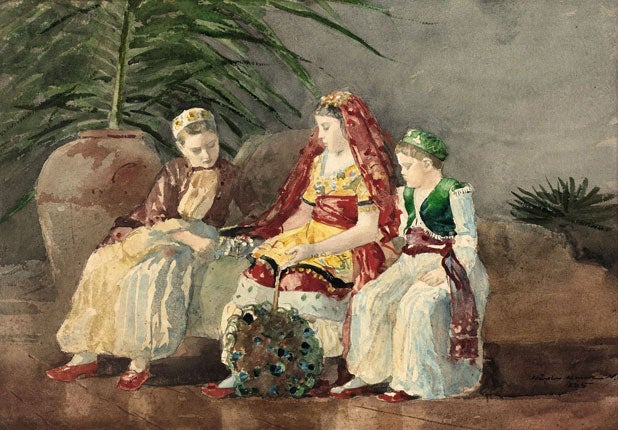Fisherman Tony Varney and his daughter Selina found an 1885 work by US watercolourist Winslow Homer outside a rubbish dump in Ireland in the 1980s. The work had apparently been abandoned. They subsequently learnt it was worth £150,000, and attempted to sell the work at auction in New York in 2009.
After learning of the sale, the painting's original owners stopped the auction, claiming the work, called Children Under a Palm Tree, was rightfully theirs. Two years on, the two families are still locked in a legal stand-off over the painting's ownership, and their story can be told in full for the first time.
"I would have willingly sat down and sorted this out," Ms Varney said. "I just don't know how long this is going to go on. I am just answering questions they are throwing at us as honestly as I can. I don't know if they are intending on striking a deal. At the moment it is just going round and round and round."
She said she was "upset" when Blake's descendants, who live at the family home in Myrtle Grove, County Cork, stopped the sale, and said the dispute had caused a "lot of heartache, a lot of grief, a lot of money".
The work shows the three children of Sir Henry Arthur Blake, a British colonial administrator who lived in the Bahamas in the late 19th century. Homer was a guest of the family and painted their children, who were holding a fancy dress party.
The watercolour remained in the family's ownership, and it travelled with them when they retired to County Cork, Ireland. It is presumed it then remained there for the ensuing decades.
However, mystery still surrounds how the painting managed to find itself outside a rubbish dump in the 1980s. While Blake's descendants claim it was stolen from their property in Myrtle Grove, they have no record of the crime taking place. Ms Varney and her lawyers argue that since her family found the work, and it remained in their possession for nearly two decades without any claim on its ownership, it now belongs to them.
"There was no crime report, and 20 years after the event it appears the family now realises it was stolen, which puts them in a very interesting legal situation," said art dealer Philip Mould, one of the presenters of Fake or Fortune?, the BBC programme which will tell the full story of the saga on Sunday.
He added: "If something was deliberately thrown away, that also makes things very complicated. Sotheby's are currently acting as Solomon, and are waiting for either party to come up with evidence it is theirs." Mr Mould identified the work on Antiques Roadshow in 2008 and has since followed every development in the family's tale with interest.
There is also a dispute over the circumstances in which Blake's descendants stopped the sale. While Sotheby's claims it contacted them when they first encountered the work, and says they raised no objection, the family says they heard nothing until they saw the auction publicised in the Sotheby's catalogue. The work now remains in the auction house's possession in New York.
"I think we would rather keep it," said Simon Murray, Sir Henry's great-great-grandson, who is representing his family's interests. "It is such a special picture. The colours are wonderful. It's a very significant part of my family's history and we really want it back."

Join our commenting forum
Join thought-provoking conversations, follow other Independent readers and see their replies
Comments